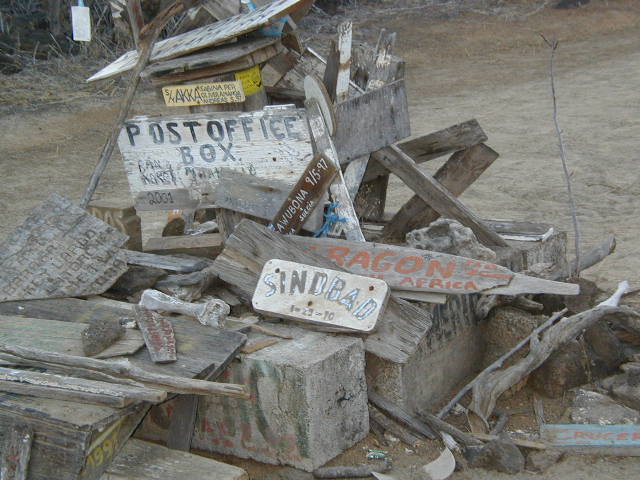
We went on to Floreana Island, where there was an optional early morning landing at the Post Office Barrel. This was a wet landing, where you get out into mid-calf deep water and wade ashore. A short walk brought us to the post office box. The tradition goes back to the whaling days, when letters were left in a barrel, to be collected by passing ships. The barrel has been replaced over the years and is now a wooden box, but the idea is still the same. The naturalists read out the addresses and people took postcards to hand deliver to those near them. Then we "mailed" our postcards.

We reboarded the pangas for a cruise around a sea lion colony. In addition to the sea lions, we saw a lot of seabirds, especially blue-footed boobies. A particular highlight was a great blue heron eating a moray eel, which it kept dunking in the water as it ate. We also saw a pair of sea turtles mating and glimpsed some penguins.
After breakfast, there was a snorkeling trip at Champion Island, a small offshore volcanic cone. I wasn't comfortable enough with snorkeling yet to go out on a deep water excursion, so I opted for the glass-bottom boat. We saw a wide variety of fish - mostly creole fish (locally called "gringos" because they're white and turn red in the sun), but also yellow-tailed surgeonfish, king angelfish, moorish idols, wrasse, and parrotfish.
Our afternoon visit was to Punta Cormorant. There was an option for a 3 p.m. swim or snorkel, as well as a 4 p.m. hike. I'd figured on swimming after the hike, but decided it was too cold then. The lesson there is to always take the first opportunity As for the hike, it was a fairly easy one, except for one (optional) rocky climb to an overlook. The trail led from a green olivine beach to a white sand beach, passing a pond of brackish water along the way. Daniel pointed out the local vegetation, including the palo santo ("holy stick") which is used for incense - and as a mosquito repellant. We smelled a bit of the sap, which is very pleasant in scent. At the pond, there were various shorebirds (e.g. a whimbrel), a couple of pin-tailed ducks, and a lot of flamingos.

The beach at the far end was spectacular. We saw stingrays in the water, as well as mating sea turtles. There was a pelican on the cliff and, as usual, a lot of the colorful Sally light-foot crabs. These large, bright orange crabs make a striking contrast with the lava. The juveniles, however, are black, and blend right in. By the way, the name is alleged to come from a Caribbean dancer and refers to their agility.

After returning to the olivine beach, we took a shorter trail, seeing more flamingos and a duck. There were samples of sea urchins laid out on a board, with a magnifying glass to help examine them. By the way, my film camera had stopped suddenly on the longer hike. I'd assumed I just had dead batteries and changed them when I came back to the ship, but to no avail. The motor had apparently died. Since this was a fairly inexpensive and old camera - and the digital camera was working fine - it wasn't a great loss, but was still annoying.
The evening's recap featured an enactment of Floreana history, starring several of the younger passengers. The story is fairly bizarre and centers around three groups of German settlers in the 1930's. Dr. Friedrich Ritter was a dentist who had all his teeth removed before arriving, so as to avoid dental problems. His mistress came with him and she eventually had her teeth pulled, too, sharing a single set of dentures with Ritter. Then there was a young couple, named the Wittmers. Finally, there was a baroness who arrived with two lovers and proclaimed herself empress of the island. She was apparently prone to walking around clad only in boots and carrying a riding crop. The three groups didn't get along well and there were a series of mysterious deaths. Ritter, who claimed to be a vegetarian, died of food poisoning after eating chicken. The baroness and one lover disappeared. . The other lover died took refuge with the Wittmers, but later died in a boating accident. The Wittmers were the only survivors and their grandchildren still live on the island.
Our New Year's Eve celebrations began with a buffet dinner. There are a number of Ecuadorean traditions we were introduced to. One wears yellow for general luck and red for luck in love. Putting money in your pockets will bring prosperity for the coming year. If you want to travel, you take a suitcase and run around the block - or, in this case, the deck of the ship. The crew read "wills" to each other, in the form of satirical poems. I couldn't understand much of the Spanish but it appeared to be mostly inside jokes anyway, which was confirmed by those who were more linguistically adept than I am. Effigies, representing the old year, were arranged on the gym deck, to be burned at midnight. Before that, a man (in this case, Franklin, one of the naturalists) dresses in drag as the widow of the old year and looks for a new husband. By the way, the effigies often represent politicians. Another tradition is to eat 12 grapes and make a wish for each month with them. I can't be certain, but I suspect I'm not the only person whose second wish was that the grapes had been seedless! There were also champagne and signal flares (to serve as fireworks) and dancing. Overall, it was fun, and certainly a different way to see in the New Year.
Back to Previous Chapter | Back to Ecuador Index | On to Next Chapter | Xenophilia Home
last updated 19 January 2002